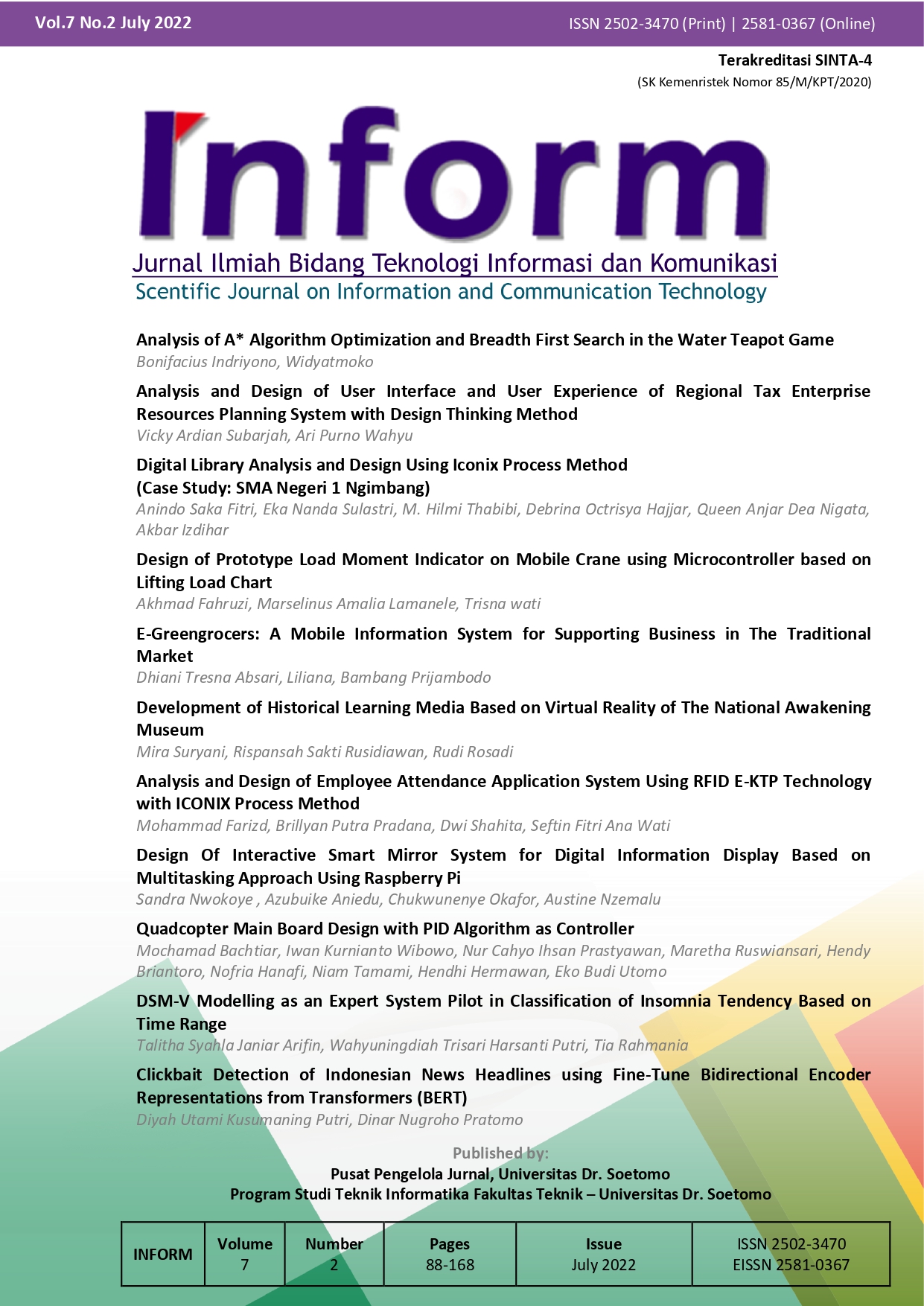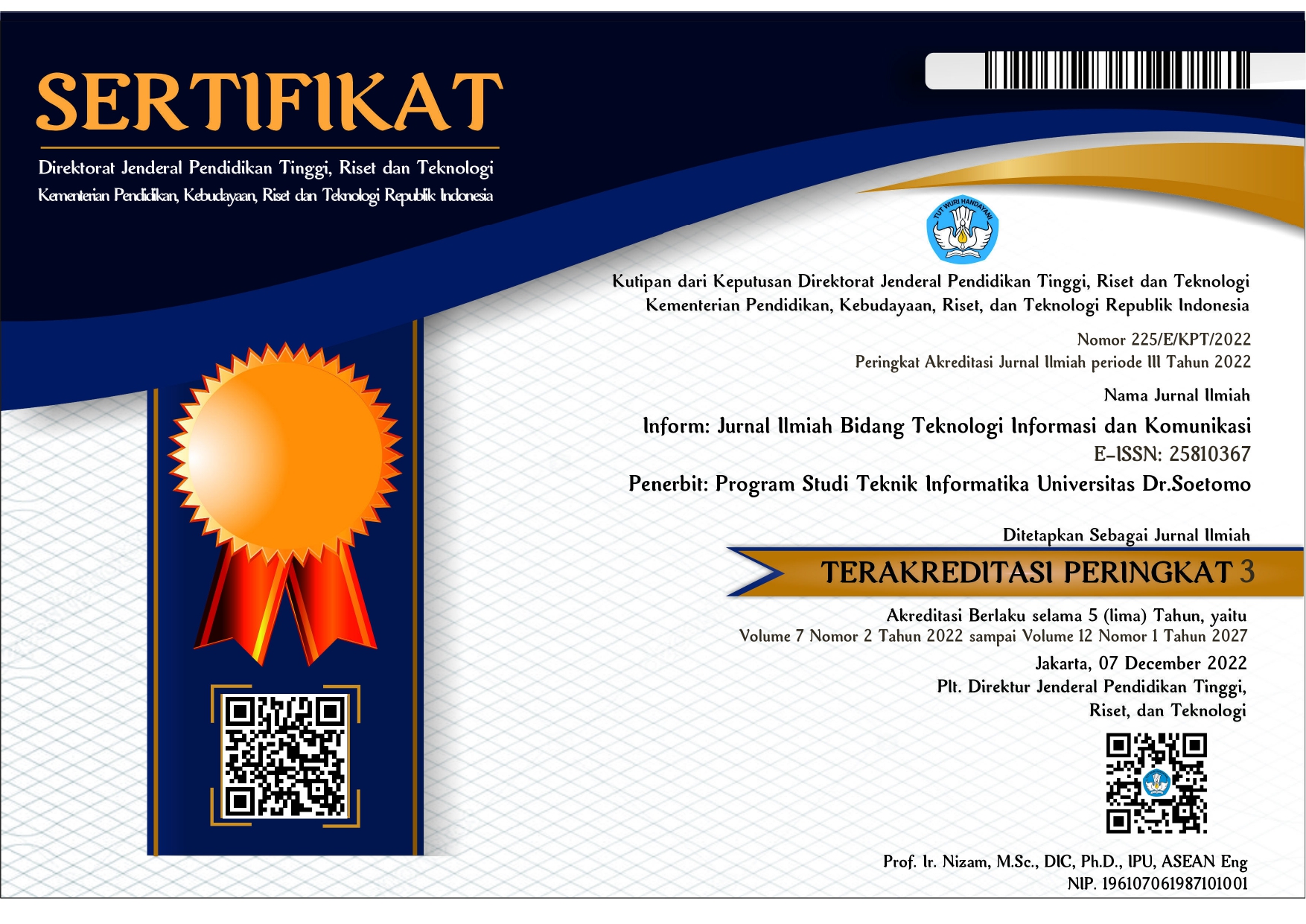DSM-V Modelling as an Expert System Pilot in Classification of Insomnia Tendency Based on Time Range
 Abstract views: 670
,
Abstract views: 670
,
 PDF downloads: 425
PDF downloads: 425
Abstract
Insomnia is a form of sleep disorder. This study develops an expert system model that can help determine the tendency of insomnia based on the Diagnostic and Statistical Manual for Mental Disorders (DSM-V) guidelines. The forward chaining design method was used in this study because it is bottom-up by collecting facts from patients and concluded based on the DSM-V guidelines. The forward chaining method was chosen to test the hypothesis of the classification of insomnia tendencies. The factual information then acts as a knowledge base fed into computer programs that can generate system rules. In addition, tacit knowledge is used, as evidenced by O'Leary validation, to strengthen the validation of psychologist practitioners. There are three validation criteria: the accuracy of the knowledge base, completeness of the knowledge base, and condition-decision matches. The parameters used are based on complaints, dysfunction, time range, and other factors. The results of modeling and analysis of the rule system using the forward chaining method classify insomnia tendencies into three types based on time range: episodic, persistent, and recurring. The validation results carried out by practicing psychologists based on the analysis showed that the three rule systems were following the DSM-V guidelines and practical experience.
References
N. Olii, B. J. Kepel, and W. Silolonga, “Hubungan Kejadian Insomnia Dengan Konsentrasi Belajar Pada Mahasiswa Semester V Program Studi Ilmu Keperawatan Fakultas Kedokteran Universitas Sam Ratulangi,” e-journal Keperawatan (e-Kp), vol. 6, no. 1, pp. 1–7, 2018.
F. Mading, “Gambaran karakteristik lanjut usia yang mengalami insomnia di Panti Wreda Dharma Bakti Pajang Surakarta,” Universitas Muhammadiyah Surakarta, 2015.
B. W. Atmadja, “Fisiologi Tidur,” J. Kedokt. Maranatha, vol. 1, no. 2, pp. 36–39, 2010.
A. H. Amalia, “Sistem Pakar Pembantu Diagnosa Penyakit Gangguan Tidur Dengan Metode Certainty Factor,” Universitas Muhammadiyah Ponorogo, 2021.
R. Noviana, Winarti, and D. Indriani, “Aplikasi Sistem Pakar Untuk Mendiagnosa Penyakit Gangguan Tidur Dengan Turbo Prolog 2.0,” in Seminar Nasional Teknologi Informasi dan Multimedia 2013, 2013.
I. D. Ananda, R. Kurniawan, N. Yanti, and F. Insani, “Sistem Pakar untuk Mendiagnosis Gangguan Tidur Menggunakan Metode Dempster Shafer,” JIMP J. Inform. Merdeka Pasuruan, vol. 6, no. 3, pp. 1–8, 2021.
I. A. Prabowo, D. Remawati, and A. P. W. Wardana, “Klasifikasi Tingkat Gangguan Tidur Menggunakan Algoritma Naïve Bayes,” J. Teknol. Inf. dan Komun., vol. 8, no. 2, pp. 40–48, 2020.
H. T. Sakti and A. Thoriq, "Expert System for Hydroponic Vegetable Cultivation Using Forward and Backward Chaining Inference Technique," Inf. J. Ilm. Bid. Teknol. Inf. dan Komun., vol. 6, no. 2, pp. 69–74, 2021.
D. S. Salsabila and R. Tanamal, "Design of Expert System for Digestive Diseases Identification Using Naïve Bayes Methodology for iOS-Based Application," Inf. J. Ilm. Bid. Teknol. Inf. dan Komun., vol. 5, no. 2, p. 92, 2020.
B. A. Dewantara, “Sistem Pakar Pembantu Diagnosa Jenis Gangguan Tidur dengan Metode Forward Chaining Berbasis PHP dan SQL,” Universtias Negeri Semarang, 2015.
W. Budiharto, AI for Beginner. BINUS (Bina Nusantara) University.
A. Al-Ajlan, "The Comparison between Forward and Backward Chaining," Int. J. Mach. Learn. Comput., vol. 5, no. 2, pp. 106–113, 2015.
F. Andika, “Pembangunan Aplikasi Sistem Pakar Gangguan Perkembangan Pervasif Dengan Metode Dempster Shafer Berbasis Web,” Universitas Atma Jaya Yogyakarta, 2015.
and G. or. C. I Made Suandi Putra MSc, CIA, C. Yullyan, SE, MAk, Ak., CPA, CIA, “PERSPEKTIF DAN PANDANGAN GLOBAL Kecerdasan Buatan (Artificial Intelligence/AI) -Pertimbangan untuk Profesi Audit Internal,” Artif. Intell., vol. 9, no. 2, pp. 1–9, 2017.
K. Lee and K. Joshi, "Understanding the Role of Cultural Context and User Interaction in Artificial Intelligence Based Systems," J. Glob. Inf. Technol. Manag., vol. 23, no. 3, pp. 1–5, 2020.
F. F. Rohman and A. Fauzijah, “Rancang Bangun Aplikasi Sistem Pakar Untuk Menentukan Jenis Gangguan Perkembangan Pada Anak,” Media Inform., vol. 6, no. 1, pp. 1–23, 2008.
A. Triyanto, “Sistem Pakar Diagnosa Penyakit Infeksi Virus Pada Anak Menggunakan Metode Forward Chaining,” Sekolah Tinggi Manajemen Informatika Dan Komputer, 2015.
C. F. Tan, L. . Wahidin, S. N. Khalil, and N. Tamaldin, "The application of expert system: A review of research and applications," ARPN J. Eng. Appl. Sci., vol. 11, no. 4, pp. 2448–2453, 2016.
Giarratano, J. C, G. D, and Riley, Expert systems principles and programming. Thomson Course Technology, 2005.
R. Rosnelly, Sistem Pakar Konsep dan Teori. Yogyakarta: CV ANDI OFFSET( Penerbit ANDl ), 2012.
G. Prastianingrum and A. S. Purnomo, “Sistem Pakar Diagnosa Fobia Menggunakan Metode Certainty Factor,” JMAI (Jurnal Multimed. Artif. Intell., vol. 3, no. 2, pp. 73–80, 2019.
B. Wijaya and R. Tanamal, “Rancang Bangun Aplikasi Sistem Pakar Berbasis Android Menggunakan Metode Forward Chaining Untuk Mendiagnosis Kerusakan Pada Hardware Laptop,” TEKNIKA, vol. 8, no. 1, pp. 25–35, 2019.
Windarsyah, H. Khatimi, and R. Maulana, “Sistem Pakar Diagnosa Jenis Gangguan Jiwa Skizofrenia Menggunakan Kombinasi Metode Forward Chaining dan Certainty Factor,” J. Teknol. Inf. Univ. Lambung Mangkurat, vol. 2, no. 2, pp. 51–58, 2017.
Darsih, M. Yani, and Herwanto, “Teori dan Implementasi Metode Forward Chaining Pada Sistem Pakar Diagnosis Gangguan Kehamilan,” in Prosiding Saintiks FTIK UNIKOM 2017, 2017.
K. A. Smith, K. Ayres, J. L. Alexander, and J. Ledford, "Initiation and Generalization of Self-Instructional Skills in Adolescents with Autism and Intellectual Disability," J. Autism Dev. Disord., vol. 46, no. 4, pp. 1196–1208, 2016.
H. I. Kaplan and B. J. Sadock, Synopsis of psychiatry: Behavioral sciences/clinical psychiatry. Williams & Wilkins Co, 1998.
P. Tyrer, D. Rutherford, and T. Hugget, "Benzodiazepine withdrawal symptoms and propranolol," Lancet, vol. 317, no. 8219, pp. 520–522, 1981.
A. Fitria, “Gangguan Insomnia pada Mahasiswa Yang Menyusun Skripsi (Studi Kasus pada Mahasiswa Jurusan Psikologi Universitas Negeri Semarang,” Universitas Negeri Semarang (UNNES), 2011.
"NIH State of the Science Conference Statement on Manifestations and Management of Chronic Insomnia in Adults Statement," J. Clin. Sleep Med., vol. 1, no. 4, pp. 412–421, 2005.
Diagnostic And Statistical Manual Of Mental Disorders (Fifth Edition) DSM-5. American Psychiatric Association, 2013.
D. E. O'Leary, "Methods of Validating Expert Systems," Interfaces (Providence)., vol. 18, no. 6, pp. 72–79, 1988.
Copyright (c) 2022 Talitha Syahla Janiar Arifin, Wahyuningdiah Trisari Harsanti Putri, Tia Rahmania

This work is licensed under a Creative Commons Attribution-ShareAlike 4.0 International License.
Authors who publish with Inform: Jurnal Ilmiah Bidang Teknologi Informasi dan Komunikasi agree to the following terms:
-
Authors retain copyright and grant the journal right of first publication with the work simultaneously licensed under a Creative Commons Attribution License (CC BY-SA 4.0) that allows others to share the work with an acknowledgment of the work's authorship and initial publication in this journal.
-
Authors are able to enter into separate, additional contractual arrangements for the non-exclusive distribution of the journal's published version of the work (e.g., post it to an institutional repository or publish it in a book), with an acknowledgment of its initial publication in this journal.
-
Authors are permitted and encouraged to post their work online (e.g., in institutional repositories or on their website) prior to and during the submission process, as it can lead to productive exchanges, as well as earlier and greater citation of published work.













